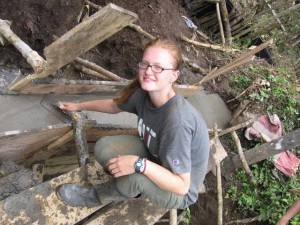Ecuador Water Project Leads to Medical Career
-
-
slice.mit.edu
Filed Under
Recommended

Guest blogger: Debbie Levey, CEE Technical Writer
Kendra Johnson '09 graduated from the University of California at San Francisco Medical School last May and began the Family Medicine residency program at Contra Costa Regional Medical Center near Oakland. Four years of MIT experience working on clean water projects in Ecuador deeply influenced her career choice and ultimate goal of practicing medicine in underserved communities.
As first-year students, Johnson and Froylan Sifuentes '09 decided to work that summer “somewhere in Spanish-speaking South American with green forests. We were thrilled that the Public Service Center’s (PSC) fellowship program would actually pay for our work,” Johnson recalled.
The two chose Santa Ana, Ecuador, an Amazon rainforest village with 35 families, with the goal of completing an unfinished local water treatment and distribution system. Studying independently with CEE lecturer Pete Shanahan ’73, PhD ’82 about filters, pipes and testing water, Kendra said, “It was so much fun to have a real practical reason for learning.”
They also received help from Alison Hynd and Sally Susnowitz in the PSC, CEE lecturer Susan Murcott ’90, SM ’92, and Amy Smith ’84, SM ’95, whose water testing kit incubated bacteria cultures without requiring electricity.
Most people in Santa Ana hauled water from “an awful, dirty river,” said Johnson. Nearby springs turned out to be even worse because they picked up germs from local latrines. “Using Amy’s water testing kit, we showed people how contaminated the water sources were, and we recommended boiling water. These people were always suffering from unsafe water, and the nearest hospital was an hour and a half away.”
Johnson described the faulty water distribution system as “a classic infrastructure problem in a developing country.” Bad design meant that river water never even entered the distribution system. During her multiple visits over four years, “eventually we got the water distribution system working—for about two weeks,” said Johnson.
However, Johnson and the villagers found a far better and cheaper alternative with 550-liter plastic storage tanks for rainwater. “These tanks systems were great! We helped the people to funnel rainwater off their tin roofs into the covered tanks, which sat on elevated platforms. Rainwater doesn’t have human fecal contamination. People loved having control over their own water, and we ended up providing rainwater system to everyone. A group from Santa Ana also helped three other communities build water tanks and taught them about safe water.”
After that first summer in Ecuador, Johnson majored in civil and environmental engineering “because I wanted to learn practical tools to learn practical things and really make a difference. In addition, I really needed to become a doctor to work with communities like this and hopefully incorporate environmental and public health.”
Johnson chose the family medicine residency because “it’s the broadest spectrum training—delivering babies, taking care of all ages, emergency medicine." She intends to live and work either in South America or in rural, underserved communities in the US.







